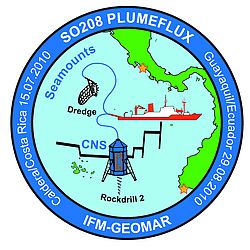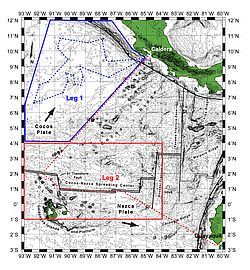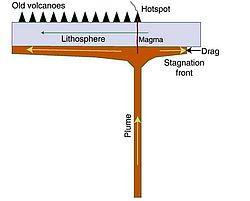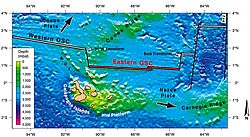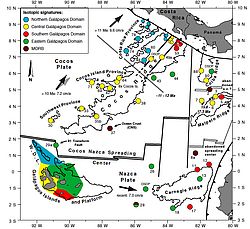Introduction and Scientific Objective
The Project PLUMEFLUX – Distribution of Galápagos plume material in the equatorial East Pacific Ocean aimes at examining igneous rocks collected during expedition SO208 of the German research vessel SONNE (http://www.rf-bremen.de/sonne.html; http://www.bgr.de/fs_sonne/).
The cruise, which started on July 15, 2010 in Caldera / Costa Rica and ended on August 29, 2010 in Guayaquil / Ecuador, is divided into two legs, in which seamounts off the coast of Costa Rica and Nicaragua (Fig. 1, Leg 1, blue area) were sampled and shallow drilling of rock formations within the area of the Cocos-Nazca Spreading Center (CNS) (Fig. 1, Leg 2, red area) were carried out. The main objectives of this multidisciplinary research project (volcanology, petrology, geochemistry, biology, sedimentology) are:
- to further our understanding of the processes related to the transport and distribution of plume material in the upper mantle,
- to characterize the compositional variation of material in the Central American trench (subduction zone),
- to reconstruct the geodynamic evolution of the Central East Pacific Ocean
- record the biodiversity and zoogeography of the research area.
During the first leg, July 15, 2010 – July 27, 2010, bathymetric mapping and rock sampling by dredging was carried out on seamounts 250 – 500 km northwest of the Cocos Ridge on the Cocos Plate. The aim was to determine whether the seamounts are “off-axis” seamounts of the East Pacific Rise (EPR) or developed due to intra plate volcanism.
The second leg, July 30, 2010 – August 29, 2010 focused on detailed mapping and sampling of several cross-sections perpendicular to the Cocos-Nazca Spreading Center (CNS) between 86°W and 92°W. The main objective is to study the plume-ridge interaction between the Galápagos mantle plume and the CNS through time at strategic locations of the ridge. The material sampled by rock drilling will be analyzed geochemically to determine the compositional variation of plume material migrating to the CNS and to possibly reveal chronological constraints to the lava stratigraphy. Within this context the following aspects are of interest:
- Does the transport of the plume material to the ridge operate in a pulsing or more continuous mode?
and - Are temporal variations at the present ridge axis comparable to compositional differences found during drilling of Site 504B (ODP Leg 111) at 6Ma?
For rock sampling the “Rockdrill 2” System of the British Geological Survey (BGS) will be used, which is a remotely operated system able to drill the top 15 m below sea floor in maximum water depth of 3000 m.
Geological Background
Galápagos is seen as the surface expression of a so-called hotspot where relatively hot mantle material, presumably originating at the core-mantle boundary, ascends to the surface, causing updoming /uplifting of the crust and localized extensive volcanism. If such a hotspot occurs beneath the oceanic lithosphere, volcanic islands may be formed, e.g. Galápagos Archipelago, Hawaiian Islands, Canary Islands. However, due to their deep source regions, mantle plumes are relatively stationary, and as the oceanic lithosphere moves over the hotspot older volcanic islands move away from the center of the plume. In exchange a new volcanic edifice is formed above the plume, and a chain of volcanoes develops, called hotspot track (Fig. 2).
The Galápagos hotspot represents a more complex case, in which a plume and a spreading center interact. The Cocos-Nazca Spreading Center (CNS) is located north of the Galápagos Archipelago and separates the Cocos Plate and Nazca Plate. For at least 20 Ma the Galápagos hotspot interacted with the CNS, resulting in the formation of two hotspot tracks; on the Cocos Plate the Cocos Ridge was formed and the Carnegie Ridge formed on the Nazca Plate (Fig. 3).
Both hotspot tracks show significant differences in their morphology as well as in their geochemical composition, interpreted as a consequence of the relative position of the spreading center to the hotspot and but not due to a variation of the geochemical composition of the Galápagos hotspot. However, the Galápagos plume material is characterized by an asymmetric, long term geochemical zonation (Fig. 4; Hoernle et al. 2000; Werner et al. 2003; Geldmacher et al. 2003).
Three geochemically enriched provinces (Northern, Central and Southern) form a horseshoe-shaped area, which encloses a depleted MORB-like Eastern domain (MORB = Mid Ocean Ridge Basalt) (e.g. White et al. 1993; Hoernle et al. 2000). Due to the distinct patterns of the incompatible trace elements and Sr-Nd-Pb-Hf isotopes the material of the Galápagos hotspot can be clearly identified and transport mechanism can be reconstructed.
Like in other hotspot areas (Hawaiian Islands, Canary Islands) the plume material presumably migrates laterally over large parts of the mantle. Preceding investigations (SO144-3, SO158 MEGAPRINT) indicate that part of the equatorial East Pacific Ocean is influenced by material of the Galápagos hotspot system. It still remains uncertain which processes are involved in these lateral mass movements. Both, off the coast of Costa Rica and Panama and in drill cores south of the Costa-Rica Rift (CRR), rocks are found which show the characteristic Galápagos signature in their chemical composition. Additionally, within the Cocos and Carnegie Ridge hotspot tracks unusually young lavas occur, which also resemble the geochemical characteristics of magmas from the Galápagos plume (O’Connor et al. 2007). Remarkably, these lavas do not fit into the geochemical zonation pattern of the older hotspot lavas. This leads to the conclusion, that this material is probably not laterally transported at the base of the lithospheric plate, but other mechanisms are responsible for the subsequent movement of plume material in these areas.
Biology
The aim of the biological investigation is an extensive survey of certain key groups of the East Pacific deep-sea benthos communities, in order to test hypotheses on their evolution, dispersal abilities and possible radiation. We will focus on two main aspects:
- Biodiversity: Representatives of key groups like Kinorhyncha, Loricifera, and Brachiopoda will be identified to species level and, where necessary, formally described as new species. Morphological as well as molecular characters will be used to analyze their phylogenetic relationships and to draw conclusions concerning their potential radiations in the deep-water environment.
- Zoogeography: Determination of species will be followed by the analysis of distribution patterns in the deep sea, adjacent seamounts and shallow water habitats in order to reconstruct the biogeographical events leading to the present species distribution. Environmental parameters like organic carbon concentration in the sediment, ambient water temperatures, pH and salinity will help to explain the observed patterns.
The cruise report of SO-208 is available here (10.6 MB).
Principle Investigators: Prof. Kaj Hoernle (project coordinator), Dr. Reinhard Werner und Dr. Folkmar Hauff
Scientific Employee: M.Sc. Antje Herbrich
Funding Source: Federal Ministry of Education and Research (BMBF)
Funding Period: 06.2010 - 08.2012
Cooperative Partners:
Dr. Carsten Lüter, Dr. Birger Neuhaus; Museum für Naturkunde der Humboldt-Universität zu Berlin, Invalidenstr. 43, D-10115 Berlin (http://www.naturkundemuseum-berlin.de/).
Dr Craig Lundstrom; Department of Geology, University of Illinois, Urbana, IL 61801, U.S.A. (http://www.geology.uiuc.edu/).
Dr. Scott White; Dept. of Earth and Ocean Sciences, University of South Carolina, 701 Sumter Street, EWS 617, Columbia, SC 29208, U.S.A. (http://www.cas.sc.edu/geol/index.htm).
Dr. John Sinton; Department of Geology and Geophysics, University of Hawai‘i at Mānoa, 1680 East-West Road, Honolulu, HI 96822, U.S.A. (http://www.soest.hawaii.edu/).
Dr. Dennis Geist; Department of Geological Sciences, University of Idaho, 825 West 7th Street, Moscow, ID 83844-3022, U.S.A. (http://www.geology.uidaho.edu).
Dr. Karen Harpp; Department of Geology, Colgate University, 13 Oak Drive, Hamilton, NY 13346, U.S.A. (http://departments.colgate.edu/geology/).
Dr. Paul van den Bogaard; FB4 – Dynamics of the Ocean Floor,Helmholtz Centre for Ocean Research, Wischhofstr. 1-3, 24148 Kiel, (http://www.geomar.de).
Dr. Dieter Garbe-Schönberg; Institute of Geosciences, Christian-Albrechts-Universität zu Kiel, Ludewig-Meyn-Straße 10, 24118 Kiel, (http://www.ifg.uni-kiel.de).
References
Christie D, Werner R, Hauff F, Hoernle K, Hanan B (2005) Morphological and geochemical variations along the eastern Galápagos Spreading Center, Geochem. Geophys. Geosyst., 6, no , Q01006, doi:10.1029/2004GC000714.
Geldmacher J, Hanan B, Blichert-Toft J, Harpp K, Hoernle K, Hauff F, Werner R, Kerr AC (2003) Hafnium isotopic variations in volcanic rocks from the Caribbean Large Igneous Province and Galápagos hotspot tracks. Geochem Geophys Geosys 4, 7: doi10.1029/2002GC000477.
Hoernle K, Werner R, Morgan JP, Garbe-Schönberg D, Bryce J, Mrazek J (2000) Existence of complex zonation in the Galápagos plume for at least 14.5. Ma. Geology 28 (5): 435–438.
O'Connor JM, Stoffers P, Wijbrans JR, Worthington TJ (2007) Migration of widespread long-lived volcanism across the Galapagos Volcanic Province: Evidence for a broad hotspot melting anomaly? Earth Planet Sci Lett 263(3-4):339-354.
Sleep, NH (2006) Mantle Plumes from Top to Bottom. Earth-Science Reviews, 77 231–271.
White WM, McBirney AR, Duncan RA (1993) Petrology and geochemistry of the Galápagos Islands: Portrait of a pathological mantle plume. J Geophys Res 98 (B11): 19.533-19.563.
Werner R, Hoernle K (2003) New volcanological and volatile data confirm the hypothesis for the continuous existence of Galápagos Islands for the past 17 m.y. Int J Earth Sci. 92, 6:.904 - 911, doi10.1007/s00531-003-0362-7.
Werner R, Hoernle K, Barckhausen U, Hauff F (2003) Geodynamic evolution of the Galápagos hostspot system (Cantral East Pacific) over the past 20m.y.: Constraints from morphology, geochemistry and magnetic anomalies. Geochem Geophys Geosys 4, 12: doi10.1029/2003GC00576.
Previously published results yielded from RV Sonne cruises SO107, 144-3, and 158
Christie D, Werner R, Hauff F, Hoernle K, Hanan B (2005) Morphological and geochemical variations along the eastern Galápagos Spreading Center, Geochem. Geophys. Geosyst., 6, no , Q01006, doi:10.1029/2004GC000714.
Díaz-Agras G (2008) Revision of the genus Pozziella (Porifera: Poecilosclerida) with description of three new species from the eastern Pacific. Zootaxa 1866: 69–94.
Geldmacher J, Hanan B, Blichert-Toft J, Hoernle K, Hauff F, Werner R, Kerr A (2003) Hafnium isotopic variations in volcanic rocks from the Caribbean Large Igneous Province and Galápagos hotspot tracks. Geochemistry Geophysics GeoSystems 4 no 7:1062, DOI 10.1029/2002GC000477.
Harpp KS, Wanless W, Otto R, Hoernle K, Werner R (2005) The Cocos and Carnegie aseismic ridges: A trace element record of Long-term plume-spreading center interaction. J. Petro l. 46: 109-133.
Heiner I, Neuhaus B (2007) Loricifera from the deep sea at the Galápagos Spreading Center, with a description of Spinoloricus turbatio gen. et sp. nov. (Nanaloricidae). Helgol Mar Res (2007) 61:167–182; DOI 10.1007/s10152-007-0064-9.
Hoernle K, Werner R, Morgan JP, Garbe-Schönberg D, Bryce J, Mrazek J (2000) Existence of complex zonation in the Galápagos plume for at least 14.5. Ma. Geology 28 no 5: 435 – 438.
Kaselowsky J, Hamamoto M, Nagahama T, Scholz J, Sterflinger K (2003) Marine Darwinfinken und schwarze Pilze. Biologie in unserer Zeit 33, 11.
Kokfelt TF, Lundstrom C, Hoernle K, Hauff F, Werner R (2005) Plume-ridge Interaction studied at the Galápagos Spreading Centre: Evidence from 226Ra-230Th-238U and 231Pa-235U isotopic disequilibria. Earth Planet Sci Lett 234 (1-2): 165-187.
Lee DE, Gregory MR, Lüter C, Zezina ON, Robinson JH, Christie DM (2008): Melvicalathis, a new brachiopod genus (Terebratulida: Chlidonophoridae) from deep sea volcanic substrates, and the biogeographic significance of the mid-ocean ridge system. Zootaxa 1866: 136–150.
Lüter C (2007) New record of Annuloplatidia annulata (Atkins, 1959) (Brachiopoda, Platidiidae) from the East Pacific. Mitt Mus Natkd Berl Zool Reihe 83: 166-169.
Neuhaus B (2004) Description of Campyloderes cf. vanhoeffeni (Kinorhyncha, Cyclorhagida) from the Central American East Pacific Deep Sea with a review of the genus. Meiofauna Marina 13: 3-20.
Neuhaus B, Blasche T (2006) Fissuroderes, a new genus of Kinorhyncha (Cyclorhagida) from the deep sea and continental shelf of New Zealand and from the continental shelf of Costa Rica. Zoologischer Anzeiger 245: 19-52.
O'Connor JM, Stoffers P, Wijbrans JR, Worthington TJ (2007) Migration of widespread long-lived volcanism across the Galapagos Volcanic Province: Evidence for a broad hotspot melting anomaly? Earth iPlanet Sci Lett 263(3-4):339-354.
Sadofsky S, Hoernle K, Duggen S, Hauff F, Werner R, Garbe-Schönberg D (2008) Geochemical variations in the Cocos plate subducting beneath Central America: Implications for the composition of arc volcanism and the extent of the Galápagos hotspot influence on the Cocos oceanic crust. International Journal of Earth Sciences: 98(4):901-913.
Werner R, Hoernle K, Bogaard Pvd, Ranero C, Huene Rv, Korich D (1999) A drowned 14 Ma old Galápagos archipelago off the coast of Costa Rica: implications for evolutionary and plate tectonic models. Geology 27 no 6: 499 - 502.
Werner R, Hoernle K (2003) New volcanological and volatile data confirm the hypothesis for the continuous existence of Galápagos Islands for the past 17 m.y.. Int. J. Earth Sci. 92, no 6:.904 - 911, DOI 10.1007/s00531-003-0362-7.
Werner R, Hoernle K, Barckhausen U, Hauff F (2003) Geodynamic evolution of the Galápagos hot spot system (Central East Pacific) over the past 20 m.y.: Constraints from morphology, geochemistry, and magnetic anomalies Geochemistry Geophysics GeoSystems 4, no 12, 1108, DOI 10.1029/2003GC000576.


